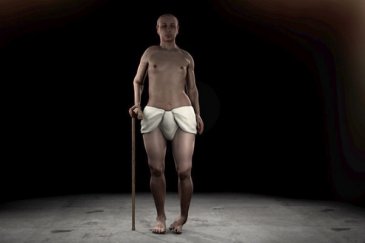Despite the beauty of King Tut's golden burial mask and his stature of Pharaoh of the Eighteenth Dynasty of Egypt, the 'boy king' would have been dealing with some serious physical impairments, new research suggests.
Ruling over Egypt between 1332 BC and 1323 BC, Tutankhamun would have done so with large, fleshy hips, a clubbed foot, and a pronounced overbite, according to new research for a BBC documentary called Tutankhamun: the Truth Uncovered.
An international team of researchers took more than 2,000 computerised tomography (CT) scans of the 19-year-old's body to construct a 3D computer model of what he would have looked like in life. Pairing the scans with a genetic analysis of his royal family, the team reports that Tutankhamun's parents were likely brother and sister, the result of which was a boy who was riddled with genetic disorders.
The research has once again opened up the debate over exactly how Tutankhamun died. It's hard to imagine this frail version of Tutankhamun dying in a chariot accident - as has long been suggested - because to die in a chariot means having the strength to command it in the first place.
"It was important to look at his ability to ride on a chariot and we concluded it would not be possible for him, especially with his partially clubbed foot, as he was unable to stand unaided," head of the Institute for Mummies and Icemen in Italy, Albert Zink, told Rose Troup Bachanan at The Independent. "We need further genetic analysis because that would give us more insight into his conditions," he said, adding that the boy also suffered from malaria and a fractured leg, which could have also had a hand in his early death.
One of the team Ashraf Selim, a radiologist at the University of Cairo in Egypt, also told Buchanan that the scan shows evidence to support the theory that King Tut "developed Kohler's disease, or death of the bones, during adolescence, which would have been incredibly painful".
Selim added that popular theories relating to the murder of King Tut have been more or less put to rest in recent years, as a large fracture in his skull was more likely the result of the mummification process than any deliberate blow to the head.
While the scan is somewhat confronting to look at, it wouldn't have come as much of a surprise to experts familiar with Tutankhamun's background. Around 130 walking sticks were found in his glittering Valley of the Kings tomb by British archaeologist Howard Carter in November 1922, suggesting that this was an important part of his mobility in life, and his overbite is a known characteristic of his family line, the Thutmosids.
Because Tutankhamun was the last male child of the Thutmosid family, with his death came the end of the Eighteenth Dynasty of Egypt. No longer ruled by lofty royal families, the nation soon found itself under the control of several powerful military figures.
Source: The Independent
